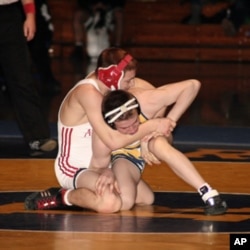There are an estimated 300,000 sports-related traumatic brain injuries in the United States each year.
A national study by a major pediatric research center of young athletes 15-to-24 years old reveals that sports are second only to motor vehicle crashes as the leading cause of injury to the brain.
And concussions represent 10 percent of all high school athletic injuries.
Alarming statistics
Every year, more than 60,000 U.S. high school athletes sustain a concussion, a type of brain injury that can be caused by a blow to the head or even the upper body. While most of them occur during a game or practice of American football, concussions can also happen in just about any other contact sport. This includes soccer, lacrosse, baseball and even wrestling.
Dane Harlowe, 17, is an award-winning athlete at Annandale High School in the state of Virginia. He has been wrestling since he was six years old.
This past February, Dane sustained a concussion when his opponent head butted him during a regular match almost immediately after the start of the match. The impact left him dazed.
"I kind of backed up a little bit and I told the ref I needed a time out," he says.
Dane’s father Dennis Harlowe, a former wrestler himself, was at the match. He knew something was wrong when he saw his son laying face down on the mat with his arms by his side while his opponent was working him.
"I’m looking and wondering ‘Why is this continuing, obviously something is wrong,’ and when Coach Sholders said, ‘There’s obviously something wrong, stop the match,’The ref blew the whistle and stopped it and it actually turned out to be the end of the match."
Importance of athletic trainers
Luckily for Dane, Annandale High School employs a certified athletic trainer. Alison Lane quickly evaluated Dane for signs of concussion, which can include confusion or fogginess, inability to think straight, a headache, nausea, dizziness and feeling off balance.
After testing the young wrestler, she determined that he did indeed have a concussion.
Lane says she’s very pleased with how her high school handles the prevention and treatment of injuries.
"We do a pre-screening where we do a baseline cognitive test where we have the athletes sit down and take a 20-minute test to see how they think cognitively when they’re healthy, so that when they do get injured and they do sustain a concussion, we can then go back and compare it. That gives us some objective data to use when we’re evaluating and deciding whether an athlete is ready to go back to play."
Rest is best
Dane was instructed to take time off from his sport and his studies to give his brain a chance to recover. He was tested again a short while later to make sure he was healed.
"I’d go down to the training room every day after school and they’d make me ride the bike and do pushups and sit ups and jumping jacks just to see if any athletic activities would give me a headache or make me dizzy or something. And then they would make me take the on-line concussion test, and I did that for two and a half weeks," he says.
Professional athletes who get concussions should also take time off, but many do not, preferring to get right back in the game. The repeated head trauma they suffer can lead to a disease called Chronic Traumatic Encephalopathy, or CTE. Symptoms - which may take years to appear - can include memory loss, aggression, confusion, erratic behavior and depression…and can lead to substance abuse and suicide.
Media attention has focused on a number of former professional football players who developed CTE - Dave Duerson, who played for the Chicago Bears for 11 seasons, shot himself to death in February. Seven years after retiring from his National Football League (NFL) career, Shane Dronett took his own life at the age of 38.
Raising awareness
But concussion-related injuries at the high school level have not attracted as much interest. In fact, only 42 percent of high schools have access to certified athletic trainers who can evaluate an athlete immediately after an incident.
And that’s a problem, says certified athletic trainer Marjorie Albohm, president of the National Athletic Trainers’ Association (NATA). "I call this truly the neglected population. We provide the best medical care for our elite highest-level athletes, internationally, and forget those millions of kids that are out there, unsupervised medically."
Albohm says coaches and parents need to be less demanding of young athletes, schedule less competitive play and be extra vigilant about injury symptoms.
Her organization is working with the National Football League to try to raise public awareness about the dangers of concussion and encourage new safety laws.













